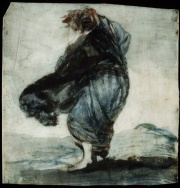Carbon black
Description
A fine particle carbon pigment obtained as soot from the incomplete combustion of many different types of organic materials, such as fruit pits, vine stalks, husks, bone, ivory, cork, resins, natural gas, or oil. Carbon black pigments have been used since ancient times. The carbon is collected as the charcoal residue, or in the case of Lampblack, as the smoke residue. Carbon black is usually a fine, soft, black powder, but some blacks contain mineral impurities and tarry hydrocarbons that give it a bluish, reddish or brownish tinge. It is very stable and unaffected by light, acids and alkalis. It absorbs ultraviolet radiation and has very good hiding properties. Carbon black has poor drying properties in oil paints, but is commonly used in printing and lithograph inks and in Chinese ink sticks. In industry, carbon black is used as a filtration material and a filler/pigment in coatings, rubber, plastics, paints, carbon paper, and crayons. As a filler, carbon black increases resistance to abrasion and adds electrical conductivity. About one fourth of the weight of a standard automobile tire is carbon black.
See also Animal black, Charcoal black.
Synonyms and Related Terms
Pigment Black 6 and 7; CI 77266; Kohlenstoffschwarz (Deut.); negro orgánico (Esp.); mayro toy anthraka (Gr.); hiilimusta (Fin.); nero di carbone (It.); noir de carbone (Fr.); sumi (Jap.); koolstofzwart (Ned.); negro de carvão (Port.); channel black
Examples include: lampblack; gas black; diamond black; smoke black; soot black; flame black; furnace black; acetylene black; thermal black; graphite; charcoal black; coal black; bone black; vine black
Risks
Once considered carcinogenic because of impurities, however, new manufacturing techniques have eliminated contamination. Chronic inhalation may cause respiratory irritation. Combustible. Burning may form toxic carbon monoxide gas.
Birla Carbon: SDS
Physical and Chemical Properties
Tiny particles, usually sub-micron in size and spherical in shape.
Insoluble in water.
| Composition | C |
|---|---|
| CAS | 1333-86-4 |
| Melting Point | 3550 C |
| Density | 1.8 - 2.1 g/ml |
| Molecular Weight | at. wt. = 12.01 |
Resources and Citations
- J.Winter, "The Characterization of Pigments Based on Carbon" Studies in Conservation 28:49-66, 1983.
- R. J. Gettens, G.L. Stout, Painting Materials, A Short Encyclopaedia, Dover Publications, New York, 1966
- Ralph Mayer, A Dictionary of Art Terms and Techniques, Harper and Row Publishers, New York, 1969 (also 1945 printing)
- The Dictionary of Art, Grove's Dictionaries Inc., New York, 1996 Comment: "Pigments"
- Michael McCann, Artist Beware, Watson-Guptill Publications, New York City, 1979
- Monona Rossol, The Artist's Complete Health and Safety Guide, Allworth Press, New York, 1994
- Thomas B. Brill, Light Its Interaction with Art and Antiquities, Plenum Press, New York City, 1980
- G.S.Brady, Materials Handbook, McGraw-Hill Book Co., New York, 1971 Comment: p. 142
- Theodore J. Reinhart, 'Glossary of Terms', Engineered Plastics, ASM International, 1988
- The Merck Index, Martha Windholz (ed.), Merck Research Labs, Rahway NJ, 10th edition, 1983 Comment: entry 1856
- The American Heritage Dictionary or Encarta, via Microsoft Bookshelf 98, Microsoft Corp., 1998
- Website: http://www.coloria.net/varita.htm - foreign language equivalent terms
- Art and Architecture Thesaurus Online, http://www.getty.edu/research/tools/vocabulary/aat/, J. Paul Getty Trust, Los Angeles, 2000
